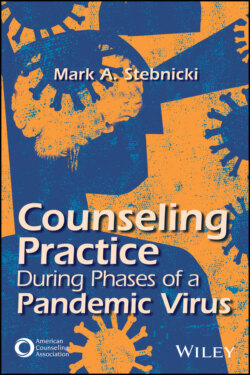Читать книгу Counseling Practice During Phases of a Pandemic Virus - Mark A. Stebnicki - Страница 21
Mental, Behavioral, Psychosocial, Medical/Physical Health as They Apply to the PRRC Theoretical Model
ОглавлениеThe PRRC theoretical model proposed here is useful for evaluating a variety of mental, behavioral, and psychosocial health risk and resiliency characteristics as they relate to the COVID-19 pandemic. Pfefferbaum and North (2020) suggested that most COVID-19 cases are treated in health care settings by medical professionals who have little or no training in the assessment, diagnosis, and treatment of psychiatric and psychosocial conditions. Thus, education and training regarding the screening of mental, behavioral, and psychosocial health issues would enhance patients’ overall medical, physical, and mental health.
Although reliable and valid self-assessments exist for clinically diagnosing anxiety, depression, posttraumatic stress, and substance use disorders, the unique characteristics and measurement of the psychological distress experienced during a public health crisis such as COVID-19 have not yet been identified in the literature (Feng et al., 2020). A preliminary scale, the COVID-19 Related Psychological Distress scale, is under development by Feng and associates (2020) to measure psychological distress due to the COVID-19 pandemic in healthy individuals. Feng et al.’s paper presents a scientific review and discussion of this instrument.
The intent of the PRRC theoretical model in this early stage of development is to provide a global theoretical measure of a person’s experience of risk and resiliency during the phases of the COVID-19 pandemic disaster. Risk and resiliency are measured within the core areas of mental, behavioral, and psychosocial health with implications for medical and physical functioning. The psychological distress caused by pandemic viruses and its implications for mental and behavioral health practice is a unique area of study in disaster mental health response. This distinctive area involves a constellation of psychologi cal states, traits, behaviors, and other factors that range from daily stressors to extraordinary stressful and traumatic events.
At this point in the development of the PRRC model, it is difficult to determine universal traits or states of mental, behavioral, and psychosocial health in response to a pandemic disaster. However, core characteristics of the COVID-19 disaster may be similar to the mental, behavioral, and psychosocial characteristics of other natural pandemic disasters, such as the HIV/AIDS epidemic in 1981, severe acute respiratory syndrome in 2003, and Middle East respiratory syndrome in 2012. The worry is that anxiety, stress, mood, and other mental health disorders have become traits of the COVID Generation (Hategan & Abdurrahman, 2020; Zvolensky et al., 2020). In other words, critical life events that occurred throughout 2020 have created stressors that have increased mental health symptoms for a new normal in mental health functioning among the general population. Chronic and persistent coronavirus stress may be difficult to distinguish from pathological traits and states of stress. Thus, theoretical models of risk and resiliency factors are vital for discovering predictors of vulnerable populations during the COVID-19 pandemic disaster (Chen & Bonanno, 2020). These unique mental, behavioral, and psychosocial health characteristics are explored and described throughout Counseling Practice During Phases of a Pandemic Virus. Here, I offer the following definitions of mental, behavioral, psychosocial, and medical/ physical health as a preliminary means of explaining the general categories in the PRRC theoretical model.
